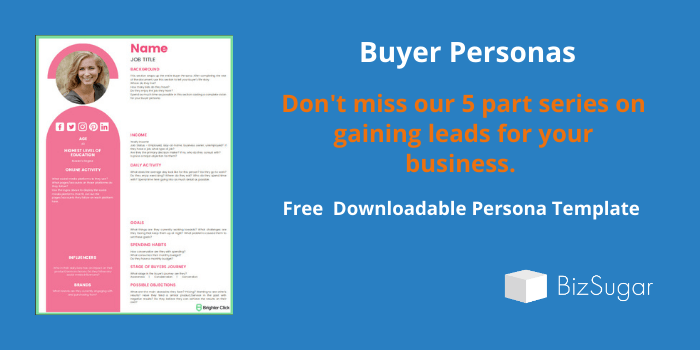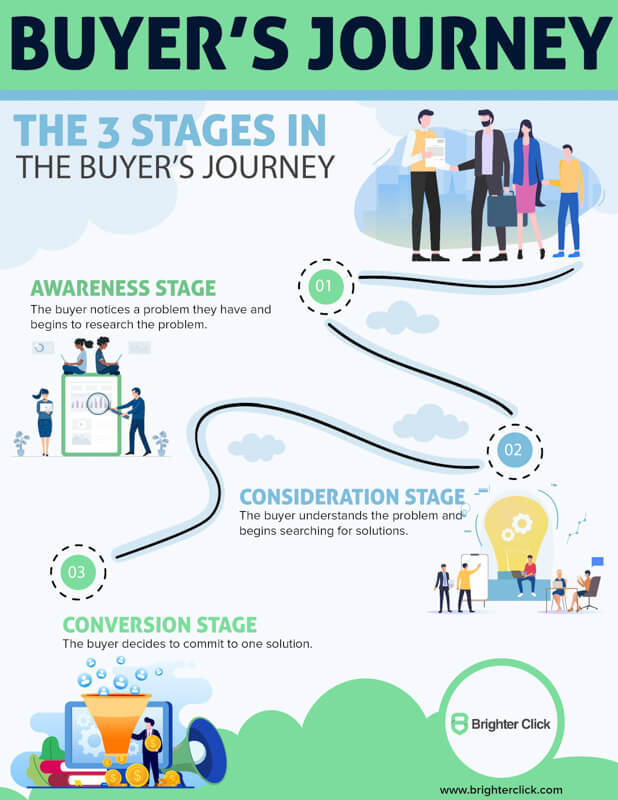
After looking at surveys given to small businesses, including the Small Business Challenges survey results recently shared by BizSugar, I saw an ongoing trend.
Businesses ranked a lack of leads as one of their main issues. Click To Tweet ” quote=”Businesses ranked a lack of leads as one of their main issues.”]You know you can provide value with your products/services, but finding the people who need your business and sharing that value opportunity with them is keeping your business from reaching its full potential.
Welcome to a new series, Gaining Leads For Your Business. In this series, we will dive deep into understanding your audience and ways you can use digital marketing platforms including:
- Your website
- Facebook ads
- Email campaigns
- Many additional methods to attract and convert your target audience
Creating Buyer Personas
In today’s post, we will walk through creating a Buyer Persona for your business.
Want to get started? Download our free Buyer Persona Template.
The Buyer Persona is a visual representation that helps you understand who the target audience is for your message.
By understanding their life, interests, and daily routines you can craft your marketing message to line up with their interests using platforms they frequent.
You could spend big bucks hiring the best agency to create a series of ads, but without defining your buyer persona, you are playing the game of luck hoping that your message will stick.
How to Build a Buyer Persona for your Marketing Plan
- Background
- Income
- Online Activity
- Spending Habits
- Daily Life
- Goals
- Possible Objections
- Stage of the Buyers Journey
Background
The background of your buyer consists of their basic information including name, age, location, education level, and marital status. The goal here is to put a face to your marketing persona.
If you currently have Google Analytics installed on your website, check to see which demographics create the highest volume of traffic.
Once again, your business may require more than one persona. If you see more than one demographic group creating a large amount of traffic, create a separate buyer persona for each.
Income
Knowing your buyer persona’s income level and their spending habits can shape the tone used in your marketing efforts.
A great way to learn more about this section is by communicating with your existing clients that fit in this buyer persona.
Online Activity
Completing the online activity section will help you see where your online marketing efforts will be most effective. Understanding what the persona engages with while on social media will also help you understand their interests.
- What are the primary social media platforms your buyer persona uses?
- What specific groups or pages are they involved with?
- How do they use social media? Are they simply viewing or are they actively posting online?
To get a better understanding of your persona’s social media engagement, use Facebook’s Audience Insight Tool.
Spending Habits
Understanding your buyer persona’s spending habits will influence how you frame offers for your products and services. Are they someone who makes decisions based on price? Do they buy impulsively? Does price come second to their desired results?
Daily Life
Completing the Daily Life Section will help you better understand what an average day looks like for your persona from waking up to going to sleep.
Knowing this will show you what forms of media they are consuming, what life factors have an impact on them, and anything other than money that may be holding them back from converting on your offer.
Stage of the Buyers Journey
Assuming everyone is at the stage of looking for a product to help their need will cause you to miss out on sales. Take the time to understand the 3 stages of the buyer’s journey, and how you can craft your message to speak to your persona at each stage.
The 3 stages in the Buyer’s Journey:
- Awareness Stage – The buyer notices a problem they have and begins to research the problem.
- Consideration Stage – The buyer understands the problem and begins searching for solutions.
- Conversion Stage – The buyer decides to commit to one solution.

Goals
Achieving your result is oftentimes not their primary goal. Take Medical Weight Loss for example. A patient may enter saying they want to lose weight, but there is an underlying goal they want to achieve.
It may be to walk on the beach with confidence. Or it may be avoiding health risks their doctor warned them of. Taking the time to understand the true reason they need your product/service is one of the most important parts of the buyer persona.
Possible Objections
Knowing your personas’ objections before they present them can help you strategize your marketing to answer the objections and move them toward the conversion stage.
Objections don’t always come from the price being too high. They may have tried the product/service of a competitor and left with a bad experience. Think outside of the box here.
We have found that client testimonials are an effective way to break down any possible objections.
Next Steps:
1. Want to get started? Download Brighter Click’s free Buyer Persona Template.
2. Join our free BizSugar Mastermind Community
3. Read the next four articles in this series (only available inside our free Mastermind Community):

Great useful article its helpful for us. Thx Author
Gaining leads for the business is very important and you have explained it very well
It’s so hard to focus on our target customer. When you’re just beginning it’s more natural to chase anyone that’s willing to speak with you. But that just wastes a lot of time. Thank you for the worksheets, I’m planning on spending the weekend on this and vow to stop chasing everyone!
Hi Colleen,
You’re absolutely correct. One of the toughest strategies to convince businesses to do is to narrow their niche. They want to consider everyone their target audience. That just leads to no one caring much about you.
The more targeted your offer, the easier you make it for your customers to know what you do and recommend you to others! I’d love to hear how the worksheets are working for you.
Your described strategies to convince businesses are very useful. This is very hard to focus on target customer at the initial stage or beginning the business. Your provided worksheet are very helpful and I hope that you will also share more posts like this.
Thanks and regards
https://www.technologiesinindustry4.com/
A brilliant piece of content is what I would say. You have given me an additional dimension of viewing my account insights. My whole concept about ‘target audience’ got refined. We have an air ticket booking portal known as ‘HappyFares’.
We offer flight tickets at the best rates, but yet are not meeting our expected results. Maybe, by following your steps, we’ll be able to target the right audience and cut down our extra costs.
Thanks once again!
infact without understant your customers profile(buyer persona) will not get far with your business
thanks
Great content! Helps defining my buyer persona!
I need to do a better job of defining my buyer persona and marketing to them.
Buyer’s person not just help you to figure what is your ideal customer but it also help to design our products to make it stand apart compare to other competitors.
Thank you very much sir, For your Great Content, I will also share my friends Once again Thank you!
It is important for a business owner to understand who their target audience is and what are their demographics and psychographics.
This is a great article.
Hello Harsh,
You may be interested in having your agency listed in our BizSugar Advisor Directory.
Respond to my comment here or message me in the Mastermind Community if you’d like more information on that.
Very informative article, and quality leads are the main factor of successful business.
This post is really great. It really gave me a new perspective.
I haven’t really thought it out like the infographic.
It will really help my Patio Paving business.
Hi, I find reading this article a joy. It is extremely helpful and interesting and very much looking forward to reading more of your work.
Its great you share here about buyer personas. That’s a common concern in the real estate business, specially with the build and sell model. We also have some tips on our site for knowing what to buy and what buyers are looking for.
Absolutely, we agree, we use our website as one of the ways to generate leads.
Thanks for the article,
Andy
it’s good İnformations.
thank you.
All too often the persona development is overlooked. Sad but true!
Hi Jay,
Thanks for your comment. I suspect that many people just don’t understand or know how to develop personas, so they just don’t do it. That probably happens more often than it being overlooked.
Thanks for the advice.
Informative one
Hey thanks for the information you provided to us. I recently setup my brand company and i hope your tips and tricks would help me in my future in growing or expanding my company.
Thanks for sharing these easy informative business buyer persona hacks with us. Keep sharing the good work ahead…
great article ,its always important to know about the customer then only a perfect strategy can be made.
Very informative article.Thanks for sharing